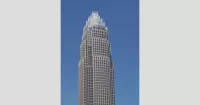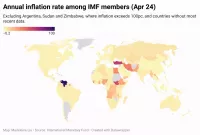Palm Springs is a desert resort city located in Riverside County, California, within the Coachella Valley. Encompassing roughly 94 square miles, it holds the distinction of being the largest city in Riverside County by land area. Notably, over 10% of the city's land is part of the Agua Caliente Band of Cahuilla Indians reservation, making it the administrative capital of California's most populated reservation.
1905: Drought Caused Damage
In 1905, an 11-year drought (1894-1905) caused damage to crops and irrigation systems in Palm Springs.
1906: Palm Springs Described as Having "Great Charms and Attractiveness"
In 1906, naturalist and travel writer George Wharton James described Palm Springs as having "great charms and attractiveness" in his book, The Wonders of the Colorado Desert. He also mentioned the comfortable microclimate due to the shadow of Mount San Jacinto.
1909: Closure of Murray's Hotel
In 1909, Murray's hotel was closed in Palm Springs.
1909: Establishment of The Desert Inn
In 1909, Nellie N. Coffman and her husband, physician Harry, established The Desert Inn as a hotel and sanitarium in Palm Springs.
October 5, 1917: Record High Temperature in Mecca
On October 5, 1917, Mecca, near Palm Springs, also reached a temperature of 117 °F (47.2 °C), setting the record for the highest temperature in the United States in October.
1918: Palm Springs Board of Trade Established
In 1918, business owners in the village established a Palm Springs Board of Trade.
1920: Publication of "Our Araby: Palm Springs and the Garden of the Sun"
In 1920, J. Smeaton Chase's book, "Our Araby: Palm Springs and the Garden of the Sun", was published, further promoting the Palm Springs area.
1922: Visitor Count Reached 20,000
About 20,000 visitors came to the Palm Springs area in 1922.
1924: Gordon Coutts Builds Estate
In 1924, Gordon Coutts, an artist in Palm Springs, constructed his Moroccan-style "Dar Marrac" estate.
1924: Construction of the Oasis Hotel
In 1924, Pearl McCallum and her husband Austin G. McManus built the Oasis Hotel in Palm Springs. The Modern/Art Deco resort was designed by Lloyd Wright and featured a 40-foot tower.
1924: City library Started
In 1924, the city library was started, financed by Martha Hitchcock.
July 1926: Start of Wettest Rain Year on Record
July 1926 marks the beginning of the wettest 'rain year' on record for Palm Springs, leading into June 1927.
1926: O'Donnell 9 Hole Golf Course Opened
In 1926, the O'Donnell 9 hole golf course opened in Palm Springs.
June 1927: End of Wettest Rain Year on Record
June 1927 concludes the wettest 'rain year' on record for Palm Springs, which began in July 1926 with a total of 17.68 inches of rainfall.
1927: Expansion of The Desert Inn
In 1927, The Desert Inn was expanded as a modern hotel in Palm Springs.
1927: Opening of the El Mirador Hotel
In 1927, the El Mirador, a large and luxurious resort opened in Palm Springs. Its prominent feature was a 68-foot-tall Renaissance style tower.
1929: Construction of Hotel del Tahquitz and El Mirador golf course
In 1929, silent film star Fritzi Ridgeway built the 100-room Hotel del Tahquitz next to the "Fool's Folly" mansion. The El Mirador golf course was also constructed.
1930: Bullock's Opened Resort Store
In 1930, Bullock's, a department store from Los Angeles, opened a "resort store" within The Desert Inn complex in Palm Springs.
1931: Desert Riders Established
In 1931, the Desert Riders organization was established, initially as a social group, which contributed to horseback riding, trail building, and chuckwagon meals for tourists.
1934: Racquet Club and The Dunes Nightclub Opened
In 1934, actors Charles Farrell and Ralph Bellamy opened the Racquet Club, and Al Wertheimer opened The Dunes nightclub outside of Palm Springs.
1936: Opening of La Plaza Shopping Center
In 1936, Southern California's first self-contained shopping center, La Plaza (Palm Springs Plaza), opened in Palm Springs.
1936: Chi Chi Nightclub Opened
In 1936, the Chi Chi nightclub opened in Palm Springs.
1936: La Plaza Built
In 1936, the historic La Plaza was built, anchoring downtown Palm Springs shopping.
January 22, 1937: Record Low Temperature
On January 22, 1937, Palm Springs recorded its lowest temperature of 19 °F or −7.2 °C.
1937: Tennis Club Opened
In 1937, Pearl McCallum opened the Tennis Club in Palm Springs.
1937: Carl Eytel Sets Up Cabin
In 1937, artist Carl Eytel established his cabin in what would later become the Tennis Club area of Palm Springs.
1938: Palm Springs High School Built
In 1938, Palm Springs High School, the oldest school in the Palm Springs Unified School District, was built.
1938: City Established by Election
In 1938, Palm Springs was officially established as a city through an election.
1940: City library Expands
In 1940, the city library expanded on land donated to the newly incorporated city by Dr. Welwood Murray and was financed through the efforts of Thomas O'Donnell.
November 1941: Palm Springs Airfield Becomes a Staging Area
In November 1941, the original airfield near Palm Springs became a staging area for the Air Corps Ferrying Command's 21st Ferrying Group.
1942: Completion of Palm Springs Army Airfield
In early 1942, the Palm Springs Army Airfield was completed.
1944: El Mirador Hotel Converted to Torney General Hospital
In 1944, the U.S. government converted the El Mirador Hotel into the Torney General Hospital, with Italian prisoners of war serving as kitchen help and orderlies.
1945: Torney General Hospital in operation
In 1945, Torney General Hospital continued to operate using Italian prisoners of war as kitchen help and orderlies.
1946: Design of the Kaufmann Desert House
In 1946, Richard Neutra designed the Kaufmann Desert House in Palm Springs. It's a modernist residence known for its use of glass, natural lighting, and flowing space.
1947: Alexander Construction Company Built Houses
Between 1947 and 1965, the Alexander Construction Company built approximately 2,200 houses in Palm Springs, doubling its housing capacity.
1947: Bullock's Opened Full Department Store
In 1947, Bullock's opened a full department store at 151 Palm Canyon Drive in Palm Springs, and J. W. Robinson's opened its own resort store in the former Bullock's location.
1950: Nellie N. Coffman's Death
Nellie N. Coffman, a driving force in Palm Springs' tourism industry, died in 1950.
1950: Desert Art Center of Coachella Valley Established
The Desert Art Center of Coachella Valley was established in Palm Springs in 1950.
1951: Thunderbird Country Club Established
In 1951, the Thunderbird Country Club was established in Rancho Mirage, marking the first 18-hole golf course in the Palm Springs area.
1954: Demolition of Murray's Hotel
In 1954, Murray's Hotel, which had closed in 1909, was torn down in Palm Springs.
1955: Ryder Cup Championship Hosted
In 1955, the Thunderbird Country Club hosted the 11th Ryder Cup championship.
April 20, 1958: "Gunsmoke" Radio Episode
On April 20, 1958, the "Gunsmoke" radio episode "The Partners" featured a commercial lauding Palm Springs.
1958: College of the Desert campus opens
In 1958, College of the Desert opened its campus at Palm Springs High School.
1958: Frank Bogert's First Mayoral Term
In 1958, Frank Bogert began his first term as mayor of Palm Springs.
1958: J. W. Robinson's Store Opens
In 1958, J. W. Robinson's opened a store at 333 Palm Canyon Drive in Palm Springs.
October 16, 1959: Saks Fifth Avenue Opens
On October 16, 1959, Saks Fifth Avenue opened at 490 Palm Canyon Dr, forming a large shopping district in Palm Springs.
1959: Changes in the Indian Leasing Act
In 1959, changes in the Indian Leasing Act allowed for long-term leases, leading to the redevelopment of Section 14.
November 1960: Robert Doisneau's Palm Springs Photography Assignment
In November 1960, French photographer Robert Doisneau pictured Palm Springs as part of an assignment for Fortune on the construction of golf courses.
1961: California Angels Spring Training
In 1961, the Major League Baseball California Angels (now the Los Angeles Angels) began using the Palm Springs stadium as their spring training site.
1963: "Palm Springs Weekend" Movie Released
In 1963, the movie "Palm Springs Weekend" was released, glamorizing Palm Springs as a spring break destination.
1964: College of the Desert campus closes
In 1964, College of the Desert closed its campus at Palm Springs High School.
1965: Alexander Construction Company Built Houses
Between 1947 and 1965, the Alexander Construction Company built approximately 2,200 houses in Palm Springs, doubling its housing capacity.
1967: Desert Fashion Plaza Mall Built
In 1967, the Desert Fashion Plaza mall was built in Palm Springs, and I. Magnin opened there.
October 1968: Local TV Stations Debut
In October 1968, Palm Springs saw the debut of its first local TV stations, KPLM-TV (now KESQ) and KMIR-TV.
1968: Section 14 Displacement
In 1968, Loren Miller, Jr., assistant California Attorney General, described the displacement of black and Latino residents from Section 14 as a "city-engineered holocaust."
1969: Joseph Magnin Co. Opens
In 1969, Joseph Magnin Co. opened a department store in the Desert Fashion Plaza mall in Palm Springs.
1969: Disturbances at Palm Springs Angel Stadium Concert
In 1969, an estimated 15,000 people gathered for a concert at the Palm Springs Angel Stadium, resulting in 300 arrests for drunkenness and disturbing the peace.
1973: Recession of 1973 Affects Palm Springs
The recession of 1973 affected Palm Springs as wealthy residents had to cut back on their spending.
1975: Recession of 1975 Affects Palm Springs
The recession of 1975 affected Palm Springs as wealthy residents had to cut back on their spending.
1982: Frank Bogert's Second Mayoral Term
In 1982, Frank Bogert began his second term as mayor of Palm Springs.
1986: Spring Break Rampage
In 1986, Palm Springs Police in riot gear had to put down a rowdy crowd of college students during spring break.
1987: J. W. Robinson's Store Closes
In 1987, J. W. Robinson's store, which opened in 1958, closed in Palm Springs.
1988: Sonny Bono Becomes Mayor
In 1988, entertainer Sonny Bono became the mayor of Palm Springs.
1990: Bullock's/Bullocks Wilshire Closes
In 1990, Bullock's/Bullocks Wilshire, which opened in 1947, closed in Palm Springs.
1990: Statue of Frank Bogert Placed
In 1990, a statue of Frank Bogert on horseback was placed in front of the Palm Springs City Hall.
1990: Palm Canyon Drive Closed to Spring Breakers
In 1990, due to complaints from residents, Mayor Sonny Bono and the city council closed Palm Canyon Drive to spring breakers, resulting in financial losses for downtown businesses.
1992: I. Magnin Closes
In 1992, I. Magnin, which had opened in the Desert Fashion Plaza mall in 1967, closed in Palm Springs.
1992: Sonny Bono Elected to Congress
In 1992, after serving as mayor, Sonny Bono was elected to the U.S. Congress.
1993: End of California Angels Spring Training
In 1993, the Major League Baseball California Angels (now the Los Angeles Angels) ceased using the Palm Springs stadium as their spring training site.
1994: Charter City Conversion
In 1994, Palm Springs converted to a charter city, with voters adopting a charter.
1997: Still Kicking: The Fabulous Palm Springs Follies documentary
Still Kicking: The Fabulous Palm Springs Follies is a 1997 Mel Damski short documentary film about the Follies.
July 2001: Start of Driest Rain Year on Record
July 2001 marks the beginning of the driest 'rain year' on record for Palm Springs, leading into June 2002.
2001: 100th Golf Course Opened
In 2001, the 100th golf course was opened in the Palm Springs area.
June 2002: End of Driest Rain Year on Record
June 2002 concludes the driest 'rain year' on record for Palm Springs, which began in July 2001 with only 0.40 inches of rainfall.
2004: Palm Springs VillageFest Development
Starting in 2004, Palm Springs collaborated with downtown businesses to develop the weekly Palm Springs VillageFest, a street fair held every Thursday evening.
2005: Palm Springs Mall Closes
The Palm Springs Mall, which had been operating since 1959, closed in 2005.
2006: Xavier College Preparatory High School built
In 2006, the Roman Catholic Diocese of San Bernardino built the Xavier College Preparatory High School in Palm Desert.
2008: Recession
Following the 2008 recession, Palm Springs revitalized its Downtown, "the Village".
2009: Median Household Income Statistics
During 2009–2013, Palm Springs had a median household income of $45,198, with 18.2% of the population living below the federal poverty line.
2010: Agua Caliente tribal enrollment in 2010
As of 2010, the Agua Caliente Band of Cahuilla Indians had a tribal enrollment of 410 people. The Agua Caliente Reservation occupies a significant portion of the city.
2010: Growth of Golf Courses in Palm Springs
By 2010, Palm Springs had grown to 125 golf courses, compared to just 19 in November 1960.
2010: Palm Springs Architecture as Model for Suburban Housing
In 2010, Culver argued that Palm Springs architecture became the model for mass-produced suburban housing, especially in the Southwest.
2010: Hollywood Values and Resort Atmosphere
In 2010, Culver explained how Hollywood values permeated the Palm Springs resort, combining celebrity, health, new wealth, and sex.
2010: Concentration of Same-Sex Couples
In 2010, Palm Springs had one of the highest concentrations of same-sex couples in the United States, with 10.1% of households belonging to same-sex married couples or partnerships.
2010: California Winter League
Since 2010, the California Winter League, a professional baseball showcase league, has been operating in Palm Springs, playing games in January and February.
2010: United States Census
The 2010 United States Census reported that Palm Springs had a population of 44,552.
2011: Tourism Boom
In 2011, Palm Springs saw 1.6 million visitors, highlighting the major role tourism plays in the city's economy.
January 2012: Downtown Revitalization Begins
In January 2012, Palm Springs began revitalizing its downtown area, known as "the Village", starting with the demolition of the Bank of America building.
2013: Median Household Income Statistics
During 2009–2013, Palm Springs had a median household income of $45,198, with 18.2% of the population living below the federal poverty line.
2013: Desert Fashion Plaza Demolition Scheduled
In 2013, the Desert Fashion Plaza was scheduled for demolition as part of the ongoing revitalization of downtown Palm Springs.
2013: Palm Springs Follies Closure
The Fabulous Palm Springs Follies closed for good after the 2013–14 season.
2014: Relocation of Forever Marilyn Statue
In 2014, the iconic Forever Marilyn statue, which was located downtown and hosted same-sex wedding ceremonies, was relocated.
2017: Canadian Tourism Impact
A 2017 study revealed that 303,600 Canadians visited the valley that year, injecting over US$236 million into various sectors of the economy.
2017: First Entirely LGBTQ City Council
In 2017, Palm Springs elected the first entirely LGBTQ city council in U.S. history, composed of one bisexual woman, three gay men, and one trans woman.
January 2018: First Fully LGBTQ Comprised City Government
In January 2018, Palm Springs ushered in America's first fully LGBTQ comprised city government.
2019: AHL Expansion Team Approved
In 2019, Palm Springs was approved to become the home to an American Hockey League (AHL) expansion team.
December 2020: Christy Holstege Takes Office
In December 2020, Christy Holstege took office as mayor, becoming the first female and openly bisexual mayor in the city's history, as well as the first openly bisexual mayor in American history.
2020: Christy Holstege Becomes Mayor
In 2020, Christy Holstege became the mayor of Palm Springs, making her the first openly bisexual mayor in the United States, as well as the first female mayor of Palm Springs.
2020: Value of El Mirador Hotel Purchase Adjusted for Inflation in 2020
In 2020, it was noted that the $750,000 the U.S. government paid for the El Mirador Hotel in 1944 would be just over $13,000,000 including inflation.
2020: Population of Palm Springs in 2020
In 2020, the census recorded the population of Palm Springs as 44,575. However, the city's population triples between November and March due to it being a popular retirement location and winter snowbird destination.
2020: United States Census
The 2020 United States census reported that Palm Springs had a population of 44,575.
2021: Canadian Second Home Ownership
According to a 2021 study by Visit Greater Palm Springs, Canadians own 7% of second homes in the valley, exceeding ownership by any other country outside the U.S.
2021: Lisa Middleton Takes Office
In 2021, Lisa Middleton became the first transgender mayor in California history.
2021: Statue of Frank Bogert Ordered to be Removed
In 2021, the City Council of Palm Springs ordered the removal of a statue of Frank Bogert due to his history and racist comments. The city also formally apologized for the eviction of Section 14 residents.
2021: Seattle Kraken Expansion Team
In 2021, the Palm Springs AHL team was intended to serve as the development affiliate of the National Hockey League's Seattle Kraken expansion team.
July 13, 2022: Relocation of Frank Bogert Statue
On July 13, 2022, after legal objections were rejected, the statue of Frank Bogert was relocated.
2022: City's Annual Comprehensive Financial Report
According to the City's 2022 Annual Comprehensive Financial Report, the top employers in the city are listed.
2022: AHL Team Launch Delayed
In 2022, the launch of the Palm Springs AHL team was delayed by one year due to the original arena project falling through.
2023: Median Household Income
In 2023, Palm Springs had a median household income of $71,979, and the per capita income was $64,811, with about 8.2% of families and 13.7% of the population below the poverty line.
2023: Foreign-born Population and Language Statistics
In 2023, the US Census Bureau estimated that 17.2% of the population of Palm Springs were foreign-born and English was spoken at home by 76.7% of people aged 5 or older.
July 5, 2024: Record High Temperature
On July 5, 2024, Palm Springs recorded its highest temperature of 124 °F or 51.1 °C.
October 1, 2024: Record High Temperature Tied
On October 1, 2024, the temperature in Palm Springs reached 117 °F (47.2 °C), tying the record for the highest temperature in the United States in October.
Mentioned in this timeline

Bank of America is a multinational investment bank and financial...
The United States of America is a federal republic located...
California is a U S state on the Pacific Coast...
The Chi is an American drama television series created by...

Inflation in economics signifies an increase in the average price...

Los Angeles is the most populous city in California and...
Trending

6 months ago Drew Carey's 'Price Is Right' buzz: Player wins big, spills secrets, and stuns fans.
2 months ago Prince George's Royal Debut: Joins Kate, King Charles at Remembrance Festival.
6 months ago Egypt seeks regional stability via dialogue, rejects Israeli escalation, Sissi tells Iran.

3 months ago Neil Patrick Harris and David Burtka Release New Cocktail and Mocktail Recipe Book.
5 months ago Musk Threatens Apple with Lawsuit Over App Store and OpenAI Favoritism.
3 months ago IonQ Stock Surges After Quantum Networking Breakthrough: A Quantum Internet Revolution?
Popular

XXXTentacion born Jahseh Dwayne Ricardo Onfroy was a controversial yet...

Ben Shapiro is a prominent American conservative political commentator media...

Candace Owens is an American conservative political commentator and author...

William Franklin Graham III commonly known as Franklin Graham is...
The Kennedy Center Honors are annual awards recognizing individuals and...

Stranger Things created by the Duffer Brothers is a popular...
